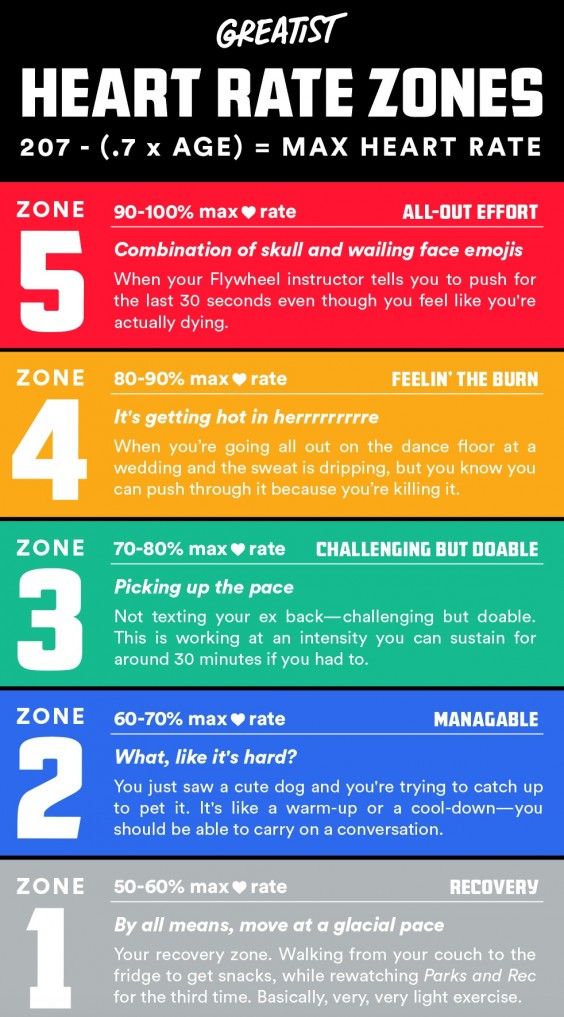We include products we think are useful for our readers. If you buy through links on this page, we may earn a small commission. Here’s our process.
Greatist only shows you brands and products that we stand behind.
Our team thoroughly researches and evaluates the recommendations we make on our site. To establish that the product manufacturers addressed safety and efficacy standards, we:- Evaluate ingredients and composition: Do they have the potential to cause harm?
- Fact-check all health claims: Do they align with the current body of scientific evidence?
- Assess the brand: Does it operate with integrity and adhere to industry best practices?
Discover the importance of cardio zones in your workout routine! Learn how to track your heart rate zones for optimal endurance, fat burning, and overall health. Understand what each zone feels like and how to measure them easily.
Unless you’re a trainer or fit-fluencer, you’re unlikely to be all, “Guys, I hit 84 percent of my max heart rate for 12 minutes today!” And if you do, props to you for knowing what that means.
But what about the rest of us who are kind of clueless, but heart rate curious? What are heart rate zones, and why are they important to keep track of, especially during workouts?
Let’s have a look.

To find your resting heart rate, take your radial pulse by placing two fingers on your inner wrist and counting the number of beats for 60 seconds. Ideally, to get the most accurate number, you should do this a few days in a row right when you wake up. Or, you can use a fitness tracker to do the work for you.
Once you know your theoretical max heart rate, you can go about figuring out which zone you fall into during activity. And if that’s just way too much math, here’s a quick look at what they mean and how each one feels.
Percentage of your max heart rate: 50–60 percent
What it’s good for: Overall health and recovery. “This is really like your recovery zone,” says Sara Dimmick, CSCS of Physical Equilibrium LLC. “So this is your long, slow duration — something that you should be able to sustain for a long time.”
What it feels like: Walking from your couch to the fridge to get snacks while rewatching “Parks and Rec” for the third time. Basically, very, very light exercise.
Percentage of your max heart rate: 60–70 percent
What it’s good for: Basic endurance and fat burning. “You’re still working, but you’re not going all out,” Dimmick says. If you’re one of those brave souls who runs marathons, this would be about your pace, French adds.
What it feels like: You just saw someone walking a really cute dog, and you’re trying to catch up to them to pet it. It’s like a warm-up or a cool-down — you should be able to carry on a normal conversation in this zone.
Percentage of your max heart rate: 70–80 percent
What it’s good for: Working up a sweat, building endurance during moderately long exercise. This is working at an intensity you can sustain for around 30 minutes if you had to, Joel says. You’re still working at your aerobic capacity (your body is using oxygen as cell energy).
What it feels like: Not texting your ex back — challenging but doable.
Percentage of your max heart rate: 80–90 percent
What it’s good for: “When you get to about 84 percent of your max heart rate, your body goes into anaerobic metabolism,” says Alec Dragelin, head coach at Orangetheory Fitness Central West End in St. Louis.. What this essentially means is your body is short on oxygen, so it has to look for other fuel sources to burn.
“You should push for about 10 minutes max at a time in this zone,” says Joel French, PhD, senior director of research, fitness, and wellness at Orangetheory Fitness. It’s in this zone that you start to get those sweet “afterburn” benefits.
“It’s called excess post-exercise oxygen consumption,” French says. For those of us who love a good acronym, it’s often referred to as EPOC. French likens these last two zones to writing a check you can’t cash — which, in this case, is a good thing. “You stress yourself a little bit more, and after the workout when you go home, your body is continuing to recover at a high rate to make up for that,” he says. “You’ll have an elevated metabolism that’s continuing to burn up fat.”
What it feels like: When you’re going all out on the dance floor at a wedding and the sweat is dripping, but you know you can push through it because you’re killing it.
Percentage of your max heart rate: 90–100 percent
What it’s good for: This is when you’re giving it your all. “You can stay in this zone [for] a max of 2 minutes, but most people usually reach their limit between 30 seconds and 1 minute,” French says.
What it feels like: When your Flywheel instructor tells you to push for the last 30 seconds, and even though you feel like you’re actually dying, you do it because you’re terrified of disappointing her. This is an all-out sprint; you’re going as hard as you can.
If you want to get specific with how to use your heart rate to your advantage in your training, it’s helpful to speak with a trainer about your goals. Heart rate change doesn’t happen in a day, so if you’re just getting started, think safety first as you push your endurance limits. In the meantime, happy sweating!
It’s important to know your max heart rate (or the maximum times your heart should beat during activity) because that will determine your heart rate for each zone. For a really long time, the formula for calculating your max heart rate was 220 minus your age, but it turns out that might no longer be the best way.
According to this study, the most recent equation used to find max heart rate is the following: HR max = 208.609-0.716 x age for males and 209.273-0.804 x age for females.
Rough translation: Take the 208.609 number if you identify as male or the 209.273 number if you identify as female and subtract 0.716 or 0.804 times your age.
For example: A 28-year-old woman would multiply her age, 28, by 0.804, which brings her to 22.512 (but we’ll round up to 23). Then she’ll subtract 23 from 209.273, which would give her a theoretical max heart rate of 187. Yay, math!
How to find the true number
And yes, it’s called a theoretical max heart rate because, well, it’s theoretical. “In order to truly determine your maximum heart rate, you would need to do a VO2 Max test, which is considered the gold standard for aerobic capacity.” And sure, you can probably find a local lab that has a VO2 tester if you want to get real intense about it, but for most of us, the formula should be enough.
You might’ve heard the phrase, “Get your heart rate up,” once or twice. We asked the experts if that should be a general goal for anyone doing activity, or if there should be some nuance involved.
“I use a Fitbit Ionic smartwatch to monitor my resting heart rate during training very closely to see if there are sudden spikes or if my heart rate fails to increase in response to exertion,” says endurance athlete Dean Karnazes. “A dramatically increased heart rate or a failure of my heart rate to increase on a normal progression can be warning signs and a reason to alter my training accordingly.”
“It really depends on your goals,” says certified personal trainer Lisa Corsello. “If endurance is a goal, then you’re going to want to keep your heart rate up for longer periods of time consistently.” Maintaining 60 to 70 percent of your maximum heart rate for 30 minutes is a great place to start — once that becomes your normal, you can build your intensity from there.
Allie Flinn is an L.A.-based beauty, fitness, and wellness writer. She’s passionate about working out, neutral colors, young adult novels, and her rescue dogs. Follow her fitness journey on Instagram @allieflinn.


